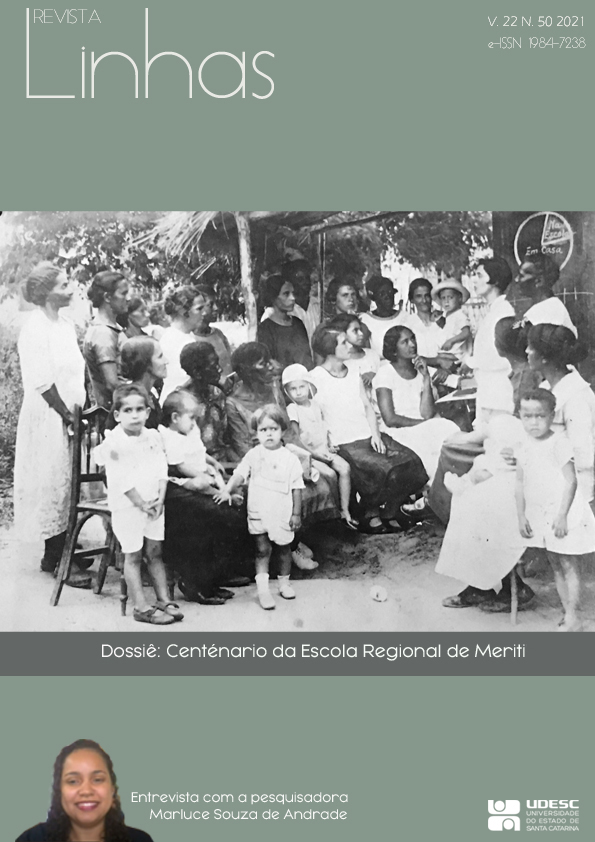Sarau Janelas Floridas: (re)existences in education and art
DOI:
https://doi.org/10.5965/1984723822502021191Keywords:
public education, art, experience, event and narrativeAbstract
We take the path of Janelas Floridas from the competition to Sarau de (Re)existence Janelas Floridas to show the strength of art as a provocative element and intensifying the power of struggle for Public Education with everyday school life against the gentrification processes of urban spaces. What can joy, play and aesthetic affections do against annihilation by capital? Sarau Janelas Floridas appears in the adventure of this answer, as it uses art and affection to strengthen the fight against the construction of a Shopping that threatens the physical structure and existence of EM Dr. Álvaro Alberto, always Regional de Meriti and, in popular memory, always Escola Mate com Angu. Expression of the voices and experiences of the school and other civil society actors that come together in a scream, a cry, a laugh, in the powerful explosion of joy. Affirming Sarau Janelas Floridas as an experience is possible through the path of singularization that its movement has designed. Born from the mobilization of education and art and managing different instances, subjects and institutions and welcomed by the school community as a movement, Sarau is produced as an event. We take, in the action plan, experience according to Dewey, when affirming the aesthetic way as the realization of an existential tension, as an act carried out and consummated of actions and perceptions that allow a singularity: that event, that day that is not lost in the dispersion of flows of the lived. In terms of reflections, we turn to Benjamin and his concept of experience as a political constitution and the act of telling his story is doing it again and listening to the narrative, the act of incorporating a new way out, an escape, into the living being's repertoire, a
a porosity.
Keywords: Public Education, art, experience, event and narrative
Downloads
References
AGAMBEN, Giorgio. O tempo que resta: um comentário à carta aos romanos. Belo Horizonte: Autêntica, 2016.
AUGÉ, MARC. O fetiche e seu objeto: abordagem etnológica. In: AUGÉ, Marc et al. O objeto em psicanálise:o fetiche, o corpo, a criança, a ciência. Campinas: Papirus, 1989.
BAUDELAIRE, Charles. Poesia e prosa: volume único. Rio de Janeiro: Nova Aguillar, 1995.
BENJAMIN, Walter. Estética e sociologia da arte.Belo Horizonte. Autêntica editora, 2017.
CERTEAU, Michel de. A invenção do cotidiano. Petrópolis: Vozes, 1994.
CRARY, Jonathan. Capitalismo tardio e os fins do sonho.São Paulo: UBU Editora, 2016.
DELEUZE, Gilles; GUATTARI, FÉLIX. Mil Platôs: capitalismo e esquizofrenia. 2. São Paulo: Ed. 34, 1995.
DELIGNY, Fernand. Os vagabundos eficazes: operários, artistas, revolucionários: educadores. São Paulo: N-1 edições, 2018.
DELIGNY, Fernand. O Aracniano e outros textos.São Paulo: N-1 edições, 2015.
DEWEY, John. A arte como experiência. São Paulo: Martins Fontes, 2010.
EVARISTO, Conceição. Olhos d’agua.Rio de Janeiro: Pallas, 2016.
GUATTARI, FÉLIX. Líneas de fuga: por outro mundo de posibles. Cuidad Autónoma de Buenos Aires: Cactus, 2013.
KRENAK, Ailton. A vida não é útil.São Paulo: Companhia das Letras, 2020.
O DIA. Escola 'Mate com Angu' completa 100 anos em Duque de Caxias, 2021. Disponível em: https://odia.ig.com.br/duque-de-caxias/2021/02/6091735-escola-mate-com-angu-completa-100-anos-em-duque-de-caxias.html. Acesso em 30 out. 2021.
MASSUMI, Brian. O que os animais nos ensinam sobre política. São Paulo: N-1 edições, 2017.
MBEMBE, Achille. Necropolítica:biopoder, soberania, estado de exceção, política da morte. São Paulo: N-1 edições, 2018.
MIGNOT, Ana Chrystina Venancio.Viajar para legitimar: Armanda Álvaro Alberto na Comissão de Intercâmbio Brasil-Uruguai (1931).Revista Brasileira de História da Educação,cidade, n. 22, p. 43-64, jan./abr. 2010.
MIGNOT, Ana Chrystina Venancio. Armanda Alberto. Recife: Fundação Joaquim Nabuco, Editora Massangana, 2010. (Coleção Educadores).
QUINTANA, Mário. Sapato florido. São Paulo: Globo, 2005.
RICOEUR, Paul. La metáfora viva. Madrid: Ediciones Trotta, 2001.
RICOEUR, Paul. La memoria, la historia, el olvido. Madrid: Ediciones Trotta, 2003.
SOURIAU, Étiene. Diferentes modos de existência.São Paulo: n-1 edições, 2020.
SANTOS,André da Rocha.Revitalização para quem?: política urbana e gentrificação no centro de Santos. Caderno Metrópole,São Paulo, v. 16, n. 32, p. 587-607, nov. 2014. Dossiê: desenvolvimento desigual e gentrificação da cidade contemporânea.
TRINDADE, Solano. Cantares ao meu povo.São Paulo: Editora Brasiliense, 1981.
VIEIRA, José Luandino. A cidade e a infância: contos. São Paulo: Companhia das Letras, 2007.
Downloads
Published
How to Cite
Issue
Section
License
Copyright (c) 2021 Revista Linhas

This work is licensed under a Creative Commons Attribution-NonCommercial-NoDerivatives 4.0 International License.
Os artigos publicados pela revista são de uso gratuito, destinados a aplicações educacionais e não comerciais. Os direitos autorais são todos cedidos à revista. Os artigos cujos autores são identificados representam a expressão do ponto de vista de seus autores e não a posição oficial da Revista Linhas ou do Programa de Pós-Graduação em Educação da Universidade do Estado de Santa Catarina.

A Revista Linhas está licenciada com uma Licença Creative Commons - Atribuição-NãoComercial-SemDerivações 4.0 Internacional.


